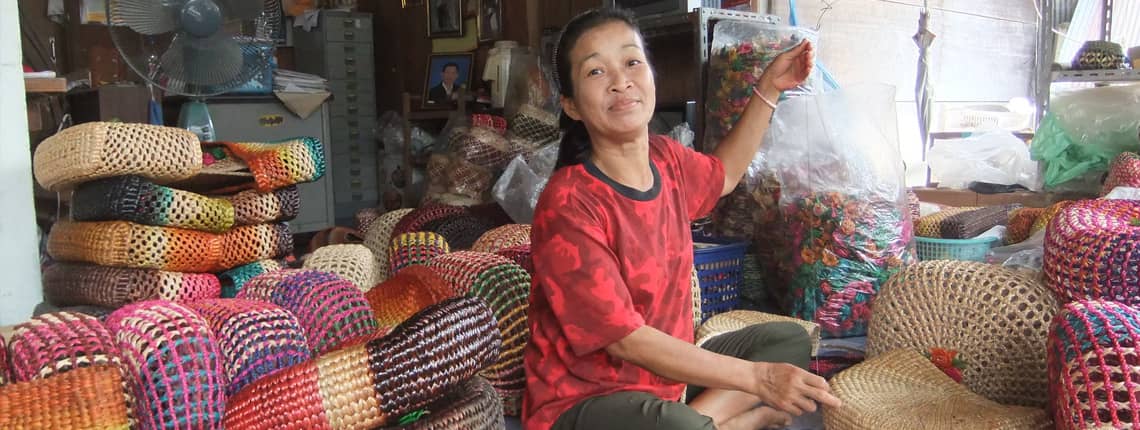
Since its “discovery” in the 1970s, the informal economy and its role in economic development have been hotly debated. Some observers view the informal economy as a “pool” of entrepreneurial talent or a “cushion” during economic crises.
Others view it more problematically, arguing that informal entrepreneurs deliberately avoid regulation and taxation. Still others see the informal economy as a source of livelihood for the working poor. Each of these perspectives is right in regard to specific components or aspects of the informal economy.
Contrary to early predictions, the informal economy has continued to grow and has appeared in new forms. Today, it represents 61 per cent of the world's workforce and a significant share of the global economy.
For a complete discussion, read WIEGO Working Paper No. 1, The Informal Economy: Definitions, Theories and Policies by Martha A. Chen. If referencing material from this paper or website, please cite the source.
Historical Perspective
1950s – 1960s
It was widely assumed that, with the right mix of economic policies and resources, low-income traditional economies could be transformed into dynamic, modern economies and petty traders, small producers and many casual jobs would be absorbed into the formal economy. This assumption was reinforced by the successful rebuilding of Europe and Japan, and the industrial expansion in Europe and North America following World War II.
By the mid-1960s, however, optimism about economic growth in developing countries began to give way to concerns about widespread unemployment and persistent traditional economy. Reflecting this concern, the International Labour Organization (ILO) mounted a series of exploratory missions to different countries to investigate the nature of the employment challenge in each country and what could be done in response.
1970s
British anthropologist Keith Hart coined the term “informal sector” during his 1971 study of economic activities among rural migrants in Accra, Ghana (Hart 1973). Hart concluded that, despite external constraints and capitalist domination, most migrants were engaged in informal activities that had “autonomous capacity for generating incomes”. See a summary of Keith Hart’s pioneering study.
The first ILO World Employment Mission was to Kenya in 1972. The mission team found that the traditional sector had not just persisted, but had expanded to include profitable and efficient enterprises as well as marginal activities (ILO 1972).
Both Hart and the Kenya mission noted the efficiency, creativity and resilience of the sector, but the concept got a mixed reception in development circles. Many held that the informal economy in developing countries was peripheral and not linked to the formal economy or to modern capitalist development and would disappear with economic growth or modern industrial development. Others argued that industrial development might take a different pattern in developing countries than in developed countries, including the expansion of informal economic activities.
1980s – 1990s
By the 1980s, the debate expanded to include changes occurring in advanced capitalist economies, where production was being reorganized into small, decentralized and more flexible economic units. These changes were associated with the informalization of employment. Standard jobs turned into non-standard or atypical jobs, with hourly wages and few benefits – or production was sub-contracted on piece rates with no benefit to small, informal units and industrial outworkers. In the process, the informal economy became a permanent, albeit subordinate and dependent, feature of capitalist development (Portes, Castells and Benton 1989).
Economic crises such as those in Latin America in the 1980s and in Asia in the 1990s demonstrated that people who lose formal jobs turn to the informal economy to earn their livelihoods. As well, high inflation often requires households to supplement formal-sector incomes with informal earnings.
During the 1990s, globalization also contributed to the informalization of the workforce in many industries and countries (Standing 1999).
Recent Years
There is renewed interest in the informal economy worldwide. In part, this is because the informal economy has not only grown, but also emerged in new guises and in unexpected places. Informal employment expanded significantly during the recent great recession (Horn 2009). It represents a significant, but largely over-looked, share of the global economy and workforce. Today, it accounts for 61 per cent of all employment globally, 67 per cent of total employment in emerging countries and 90 per cent total employment in developing countries (see ILO 2018).
There has also been an increased recognition that the informal economy is linked to the formal economy and contributes to the overall economy, and that supporting the working poor in the informal economy is important for reducing poverty and inequality, just as supporting working poor women in the informal economy is important for reducing gender inequality.
While interest in the informal economy has waxed and waned, the concept continues to be useful to many policymakers, activists and researchers. This is because of the significance of the reality that it seeks to capture: the large share of the global workforce and production that remains outside the world of full-time, stable and protected employment.
The informal economy is now a field of study in its own right, involving scholars from many disciplines, including economics, gender studies, industrial relations, law, management, political science, sociology, social policy and urban planning. Recent scholarship focuses, variously, on the size and composition of the informal economy, what drives or causes informality, what are the consequences of informality in terms of welfare or productivity, and the linkages between informality and formality, growth, poverty and inequality.
Dominant Schools of Thought
Some observers view the informal economy in positive terms, others in negative terms, often for different reasons. Underlying these varying perspectives are four schools of thought regarding the informal economy in developing countries.
- The dualist school sees the informal economy as comprised of marginal activities that are distinct from and not related to the formal sector and that provide income for the poor and a safety net in times of crisis (Hart 1973; ILO 1972; Sethuraman 1976; Tokman 1978).
- The structuralist school sees the informal economy as subordinated economic units (informal enterprises) and workers that serve to reduce input and labour costs of large capitalist firms and, thereby, increase their competitiveness (Moser 1978; Castells and Portes 1989).
- The legalist school sees the informal economy as comprised of plucky entrepreneurs who choose to operate informally in order to avoid the unnecessary and burdensome costs, time and effort of formal registration and who need legal rights to convert their assets into formal property (de Soto 1989, 2000).
- The voluntarist school sees the informal economy as comprised of entrepreneurs who choose to operate informally in order to avoid taxation, commercial regulations, electricity and rental fees, and other costs of operating formally (e.g. Maloney 2004).
Another approach, often focused on transitional and developed countries, views the informal economy as activity that is illegal, or hidden/underground. The System of National Accounts (SNA) defines illegal production as production activities which are forbidden by law or which become illegal when carried out by unauthorized producers. Underground production is legal when performed in compliance with regulations, but is ofen deliberately concealed from authorities. However, most informal activities are not underground or illegal, but instead reflect a survival strategy (Hussmanns 2004).
More Heat than Light
The debates between these dominant schools of thought have tended to generate more heat than light – in large part because each has focused on a “slice of the (informal economy) pie,” not the whole pie. The dualists focus on those engaged in traditional and survival activities; the structuralists on petty traders and producers as well as sub-contracted workers; both the legalists and voluntarists on informal enterprises and entrepreneurs.
A Holistic Approach
Given the heterogeneity of the informal economy, there is merit to each of these perspectives. Each school reflects one or another part of the informal economy. But the informal economy as a whole is more complex than the sum of these perspectives would suggest.
Some informal entrepreneurs choose, or volunteer, to work informally. Yet informal employment tends to expand during economic crises or downturns, suggesting that necessity – in addition to choice – drives informality. Also, informalization of employment relations is a feature of contemporary economic growth and the global economy, often associated with the hiring practices of formal firms. Further, in many developing countries, the vast majority of the workforce has never had a formal job and continues to engage in traditional or survival activities.
What is called for is a holistic approach to the informal economy that takes into account all aspects of informality and all categories of informal workers.
- In their 2007 publication called Informality: Exit and Exclusion, a team of authors from the Latin American Division of the World Bank proposed a holistic model of the composition and causes of informality: see the World Bank framework.
- In 2009, Ravi Kanbur posited a conceptual framework for distinguishing between four types of responses by entrepreneurs to regulation. See Kanbur’s ABCD framework.
- The WIEGO Network has also developed a holistic model of the composition and causes of informality. See WIEGO’s holistic framework.
Informality of Capital and the State
Finally, it should be noted that Capital and the State, not just Labor, operate informally.
Corporations often hire workers informally. In fact, informal employment in formal firms is the fastest growing component of informal employment in many countries. Corporations also often avoid taxes. Further, different levels of government often collude with corporations or big businesses to identify or create loopholes in existing rules and regulations to serve their mutual interests.
Consider the case of cities. Local city governments set the legal rules of the economic (or urban) game but then, often in collusion with big business (notably real estate developers), take advantage of loopholes in existing regulations or make exceptions to these regulations to serve their own interests and those of the rich and powerful classes.
In her study of urban planning in India, urban theorist Ananya Roy contrasts the collusion of city governments with housing authorities and real estate developers in the appropriation of public land for private housing (“elite informality”) with the criminalization by city governments of the appropriation of public land by the urban poor for their settlements (“subaltern informality”). Roy concludes: “The planning and legal apparatus of the state has the power to determine… what is informal and what is not, and to determine which forms of informality will thrive and which will disappear….to construct and reconstruct categories of legitimacy and illegitimacy” (Roy 2005).
